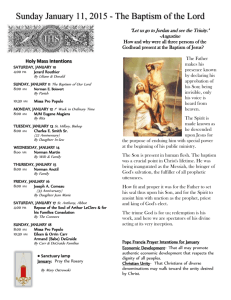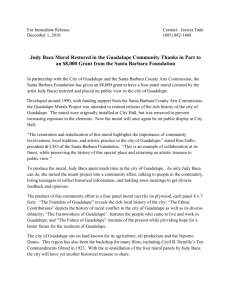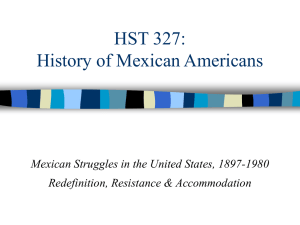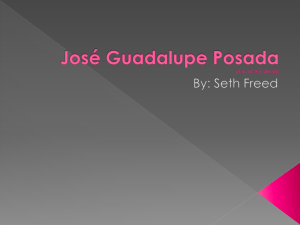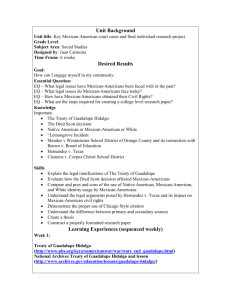Guadalupe, Malinche & México
advertisement
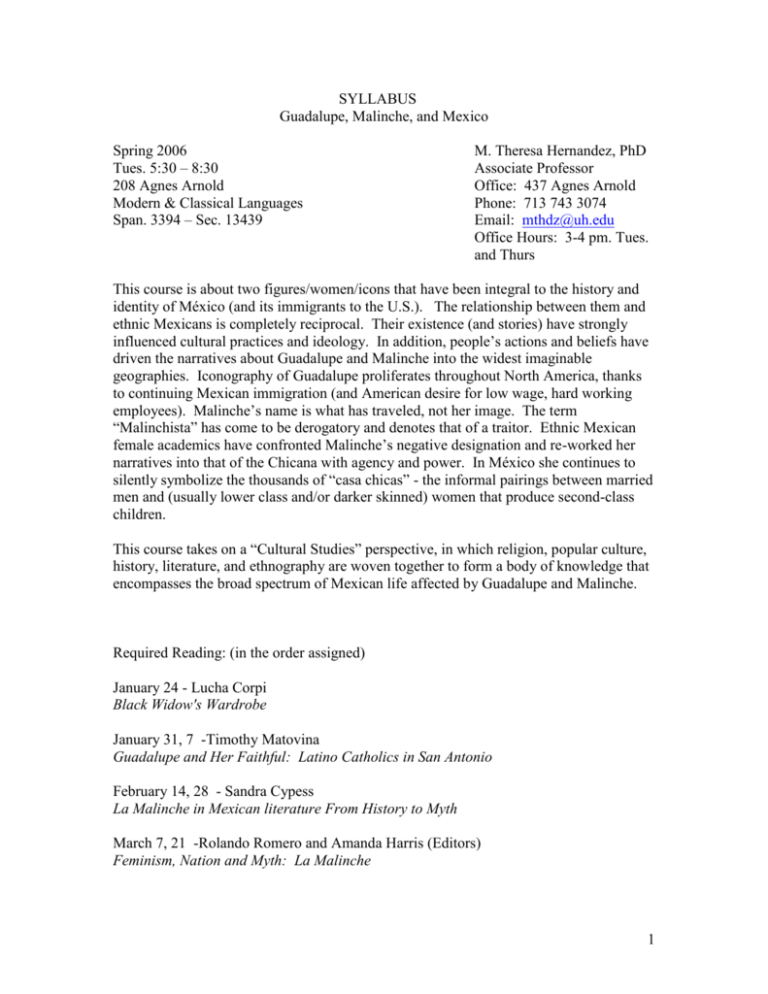
SYLLABUS Guadalupe, Malinche, and Mexico Spring 2006 Tues. 5:30 – 8:30 208 Agnes Arnold Modern & Classical Languages Span. 3394 – Sec. 13439 M. Theresa Hernandez, PhD Associate Professor Office: 437 Agnes Arnold Phone: 713 743 3074 Email: mthdz@uh.edu Office Hours: 3-4 pm. Tues. and Thurs This course is about two figures/women/icons that have been integral to the history and identity of México (and its immigrants to the U.S.). The relationship between them and ethnic Mexicans is completely reciprocal. Their existence (and stories) have strongly influenced cultural practices and ideology. In addition, people’s actions and beliefs have driven the narratives about Guadalupe and Malinche into the widest imaginable geographies. Iconography of Guadalupe proliferates throughout North America, thanks to continuing Mexican immigration (and American desire for low wage, hard working employees). Malinche’s name is what has traveled, not her image. The term “Malinchista” has come to be derogatory and denotes that of a traitor. Ethnic Mexican female academics have confronted Malinche’s negative designation and re-worked her narratives into that of the Chicana with agency and power. In México she continues to silently symbolize the thousands of “casa chicas” - the informal pairings between married men and (usually lower class and/or darker skinned) women that produce second-class children. This course takes on a “Cultural Studies” perspective, in which religion, popular culture, history, literature, and ethnography are woven together to form a body of knowledge that encompasses the broad spectrum of Mexican life affected by Guadalupe and Malinche. Required Reading: (in the order assigned) January 24 - Lucha Corpi Black Widow's Wardrobe January 31, 7 -Timothy Matovina Guadalupe and Her Faithful: Latino Catholics in San Antonio February 14, 28 - Sandra Cypess La Malinche in Mexican literature From History to Myth March 7, 21 -Rolando Romero and Amanda Harris (Editors) Feminism, Nation and Myth: La Malinche 1 April 4, 11, 18 - David Brading Mexican Pheonix: Our Lady of Guadalupe, Image and Tradition Across Five Centuries April 25 - Brading, Mexican Pheonix. Selections from La Jornada (México City) on Rector Schulenberg. Requirements: Essays: 2 seven page essays - due March 7, and April 4 (20% each) 40% Class Presentation and participation-discussion (20 % each) 40% Final Paper - 12 pages, will count as grade for final exam (20%) 20% total 100% ATTENDANCE Students wanting to make an "A" or "B" in the course cannot be absent for more than one class during the semester. Anyone missing more than one session will automatically make a C (or less depending on their other grades). January 24 - Read La Virgen de Guadalupe Se Fue de Mojada http://www.jornada.unam.mx/2006/01/17/023a2pol.php Movie, Tizoc: Amor Indio January 31 - Corpi, Black Widow's Wardrobe. Selection from R.E. Rodriguez, “Cultural Memory and Chicanidad,” Contemporary Literature. 43, 1, 138-70, Spring 2002. Pages from this excerpt 159-165. How does the narrative work with history and memory in the present? Considering this is a novel, how “accurate” is Corpi in her historical representation (and why)? February 7 Matovina, Guadalupe and Her Faithful. Intro., Chapter 1-4. Matovina is a former priest. Do you think his history may have affected his research? What about a non Latino writing on Guadalupe? February 21 Matovina, Guadalupe and Her Faithful. Chapter 5 and Epilogue Compare how Guadalupe is viewed (as expressed by Matovina) in the present, versus colonial times? How have city and ethnic politics affected (or been affected by) Guadalupe’s followers and their practices? February 28 Cypess, La Malinche Cypess’ focus is more literary and narrow. What is her position? Is he wanting to re-invent Malinche as does Corpi? What about the idea of rape vs. seduction, betrayal or force? 2 March 7 Cypess, La Malinche What do you think of Marina’s decisions regarding La Noche Triste? Which of her actions have affected Mexican society the most? March 21 Feminism, Nation and Myth: La Malinche. Intro. to p. 81 There is more than ten years between the publication of Cypess’ book and Feminism, Nation and Myth. How doe the two connect (or disconnect)? Do the authors from Feminism, Nation and Myth seem to be more aware of the global implications -how do they demonstrate this? March 28 Feminism, Nation and Myth: La Malinche . Page 82-159 How is anger and resentment dealth with in the essays? Discuss the rational for these positions? Where do you stand on this? How would you discuss this with your classmates? Family? Friends? April 4 Brading, Mexican Pheonix. Intro- Chapter 1-4. i -p. 95 What is Brading’s position on the validity of the Virgin’s apparition? What is your opinion after reading these chapters? April 11 Brading, Mexican Pheonix. Chapter 5-7 p. 96-168 Was it really the epidemics and how Guadalupe “saved” México City that affected political opinion? April 18 Brading, Mexican Pheonix. Chapter 8-10. p. 169-257 How was the connection with Tonanztin viewed by the late 1700’s (eighteenth century)? How was the famous sermon by Servando Teresa de Mier connected with contemporary beliefs in Guadalupe? What do you make of his ideas and how he was disciplined? April 25 Brading, Mexican Pheonix. Chapter 11-15. p. 258-368 Readings from La Jornada on Rector of Basilica de Guadalupe, Schulenberg. The debate on Juan Diego continues. What do you think of Brading’s position? Why do you think Juan Diego was not canonized until the twentieth century? What about Brading writing about Guadalupe as an English academic? How does the controversy with Schulenber and Juan Diego fit in? May 11 Final Papers Due at 2 pm. 3
